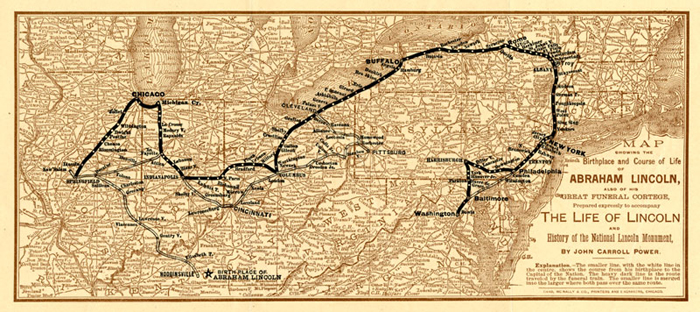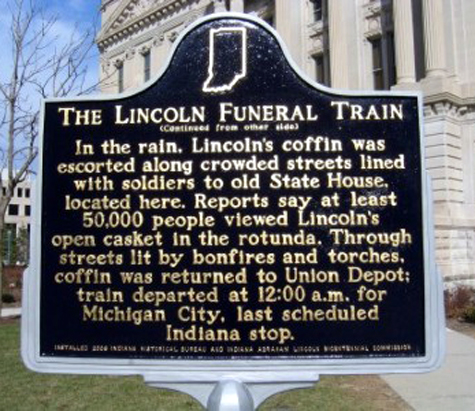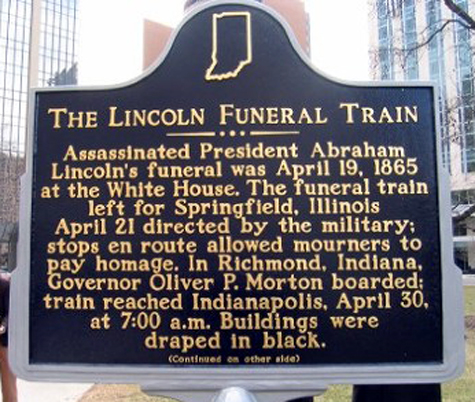
Just five days following the close of the Civil War, President Abraham Lincoln died April 15, 1865 after being shot the night before by John Wilkes Booth at Ford's Theatre in Washington, D.C.
Following the president's funeral, a train carrying Lincoln's coffin left Washington, D.C. on April 21, on its way to Springfield where he was buried on May 4. The train traveled 1,654 miles through 180 cities and seven states on its way to Lincoln’s home state of Illinois. Approximately 300 people accompanied Lincoln’s body on the journey, including his eldest son Robert.
Newspapers publicized the train’s schedule so that citizens could pay their last respects as it passed. In 10 cities, the president’s casket was removed from the train for elaborate memorial services and public viewings. On May 3, 1865, the train reached its final destination.
Locally, a brief account of the funeral train was written by J.V. Bechdolt who wrote a history of the Francesville community.
"The train passed through Francesville soon after daylight. Many citizens gathered to see it pass. It stopped long enough at the old wood shed to take on wood and water, and people had a full view of the casket containing the body of the President through the glass sides of the coach. A guard of honor stood at either side of the casket ... people seemed to stand in dumb and sorrowful awe, realizing that a national calamity had befallen them and that they were on the threshold of Reconstruction without a trusted leader."
The towns of Francesville and Medaryville were both founded in 1853 as watering stops for the new railroad; both were only 12 years in existence when the funeral train passed through.
There is also this little anecdote from the Starke County Historical Society:
"John Tierney was 15 years old that day the train came to San Pierre. When he first heard the train would be coming, he became determined to attend Mr. Lincoln’s funeral in Springfield, Illinois. He managed to hop the train as it was leaving, unnoticed by the train personnel, but found shortly after he was on the train. Even though John Tierney believed the train was headed directly to Springfield, it was destined for Chicago for exhibition, along with many other short stops on the way. It would be several days before the train would reach Springfield. John Tierney, after explaining his sincere wish to pay his respect to the much admired Lincoln, and the fact that he was the only individual up to that point that had successfully boarded the train, was allowed to continue the ride."
 |
 |
As it turns out, Tierney's story is confirmed by Nathan Origer, the executive director of the Pulaski County Community Develpment Commission.
Origer says that when the funeral train arrived in San Pierre, Tierney (the man who eventually donated the land for the Little Company of Mary complex) "hopped on the train, at age 15, and rode it all the way to Springfield, Ill. When Tierney was 90, in the early 1940s, my grandfather and his brother-in-law installed new tile at the home where he lived (and where nuns were carrying for him). Grandpa and my grand-uncle (Dan Dolezal’s dad, actually - I think it was!) were invited to stay for a birthday celebration, at which Mr. Tierney told his Lincoln train tale."
Of the funeral train's stop in Indianapolis, the Indianapolis Journal reported: “The unpropitious weather prevented the funeral pageant, but an offset to the disappointment of the people in this, was the increased facility given to view the remains as they lay in state at the Capitol. Every Indianian may feel that the honor of the State has been rather brightened than compromised by their reception of the remains of President Lincoln, and that the State where he passed some years of his youth, has rendered her full quota of honor to him as the Savior of his Country.”
Also of the Indianapolis stop, poet Carl Sandburg (1878-1967) wrote: “Tolling bells and falling rain at Indianapolis saw the coffin borne into the State House for a Sabbath to be remembered. From Cincinnati, Ohio, and Covington, Kentucky, had come the City Councils. From Kentucky had come her Governor Thomas E.’ Bramlette and others. Pilgrims arrived from the southern counties where the boy Lincoln had learned to read and write, had walked many miles seeking books to read. Again was the inscription where all might read: ‘He Sleeps in the Blessing of the Poor, Whose Fetters God Commanded Him to Break,’ and another: ‘To Live in Hearts We Leave Behind is Not to Die.’ In all churches the sermons were on the life of the one-time Hoosier boy. A venerable veteran of forty years’ Sunday-school service, Colonel James Blake, marshaled five thousand Sunday-school children for marches to the State House. One hundred and fifty persons a minute passed the coffin, an estimated total of one hundred thousand."
(From Carl Sandburg, Abraham Lincoln: The War Years, Volume IV, p. 408.)
|
A replica of the Lincoln Funeral Train Car will be on display at the annual Francesville Fall Festival, Sept. 18-20, 2015. |
After departing Indianapolis in the early hours of May 1, the funeral train reached Lafayette at 3:35 a.m. The Indianapolis Daily Journal reported on the scene at Lafayette: “The houses on each side of the railroad is [sic] illuminated, and; as elsewhere, badges of mourning and draped flags are displayed; bonfires are blazing and bells tolling; mournful strains of music are heard, and the people are assembled at all the stations to view the train.”
After leaving Lafayette, the train traveled through "Battle Ground, Brookston, Chalmers, Reynolds, Bradford, Francisville (5:35 a.m.), Medaryville (5:50 a.m.), Kankakee, La Crosse, Wanatha, Westville, and La Croix," before reaching Michigan City and then continuing to its next big stop in Chicago, according to the train itinerary.
Also transported on the funeral train was a coffin containing the body of Lincoln’s son Willie, who had died in 1862 at the age of 11 of typhoid fever during Lincoln’s second year in office. Willie’s body had been disinterred from a plot in Washington, D.C. after Lincoln’s death so he could be buried alongside his father at the family plot in Springfield.
In 1911, a prairie fire near Minneapolis, destroyed the train car that had carried Lincoln’s body to Springfield.
For more reading on the LIncoln Funeral Train, a recent issue of National Geographic has a cover story on the event: http://ngm.nationalgeographic.com/2015/04/lincoln-funeral-train/goodheart-text







